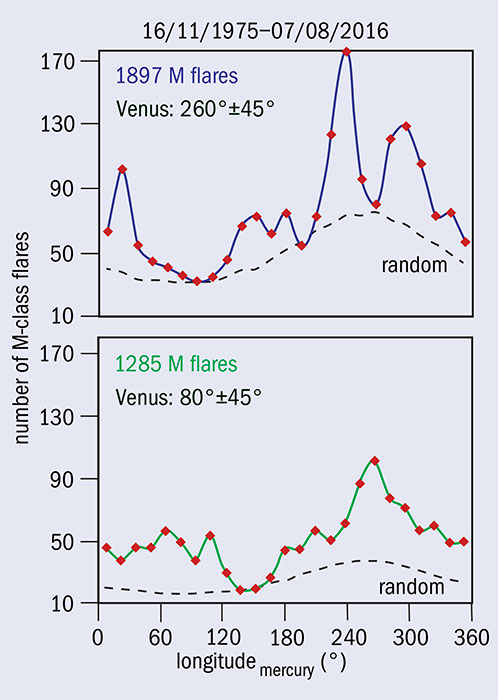
The origin of solar flares, powerful bursts of radiation appearing as sudden flashes of light, has puzzled astrophysicists for more than a century. The temperature of the Sun’s corona, measuring several hundred times hotter than its surface, is also a long-standing enigma.
A new study suggests that the solution to these solar mysteries is linked to a local action of dark matter (DM). If true, it would challenge the traditional picture of DM as being made of weakly interacting massive particles (WIMPs) or axions, and suggest that DM is not uniformly distributed in space, as is traditionally thought.
The study is not based on new experimental data. Rather, lead author Sergio Bertolucci, a former CERN research director, and collaborators base their conclusions on freely available data recorded over a period of decades by geosynchronous satellites. The paper presents a statistical analysis of the occurrences of around 6500 solar flares in the period 1976–2015 and of the continuous solar emission in the extreme ultraviolet (EUV) in the period 1999–2015. The temporal distribution of these phenomena, finds the team, is correlated with the positions of the Earth and two of its neighbouring planets: Mercury and Venus. Statistically significant (above 5σ) excesses of the number of flares with respect to randomly distributed occurrences are observed when one or more of the three planets find themselves in a slice of the ecliptic plane with heliocentric longitudes of 230°–300°. Similar excesses are observed in the same range of longitudes when the solar irradiance in the EUV region is plotted as a function of the positions of the planets.
If true, our findings will provide a totally different view about dark matter
Konstantin Zioutas
These results suggest that active-Sun phenomena are not randomly distributed, but instead are modulated by the positions of the Earth, Venus and Mercury. One possible explanation, says the team, is the existence of a stream of massive DM particles with a preferred direction, coplanar to the ecliptic plane, that is gravitationally focused by the planets towards the Sun when one or more of the planets enter the stream. Such particles would need to have a wide velocity spectrum centred around 300 km s–1 and interact with ordinary matter much more strongly than typical DM candidates such as WIMPs. The non-relativistic velocities of such DM candidates make planetary gravitational lensing more efficient and can enhance the flux of the particles by up to a factor of 106, according to the team.
Co-author Konstantin Zioutas, spokesperson for the CAST experiment at CERN, accepts that this interpretation of the solar and planetary data is speculative – particularly regarding the mechanism by which a temporarily increased influx of DM actually triggers solar activity. However, he says, the long persisting failure to detect the ubiquitous DM might be due to the widely assumed small cross-section of its constituents with ordinary matter, or to erroneous DM modelling. “Hence, the so-far-adopted direct-detection concepts can lead us towards a dead end, and we might find that we have overlooked a continuous communication between the dark and the visible sector.”
Models of massive DM streaming particles that interact strongly with normal matter are few and far between, although the authors suggest that “antiquark nuggets” are best suited to explain their results. “In a few words, there is a large ‘hidden’ energy in the form of the nuggets,” says Ariel Zhitnitsky, who first proposed the quark-nugget dark-matter model in 2003. “In my model, this energy can be precisely released in the form of the EUV radiation when the anti-nuggets enter the solar corona and get easily annihilated by the light elements present in such a highly ionised environment.”
The study calls for further investigation, says researchers. “It seems that the statistical analysis of the paper is accurate and the obtained results are rather intriguing,” says Rita Bernabei, spokesperson of the DAMA experiment, which for the first time in 1998 claimed to have detected dark matter in the form of WIMPs on the basis of an observed seasonal modulation of a signal in their scintillation detector. “However, the paper appears to be mostly hypothetical in terms of this new type of dark matter.”
The team now plans to produce a full simulation of planetary lensing taking into account the simultaneous effect of all the planets in the solar system, and to extend the analysis to include sunspots, nano-flares and other solar observables. CAST, the axion solar telescope at CERN, will also dedicate a special data-taking period to the search for streaming DM axions.
“If true, our findings will provide a totally different view about dark matter, with far-reaching implications in particle and astroparticle physics,” says Zioutas. “Perhaps the demystification of the Sun could lead to a dark-matter solution also.”





